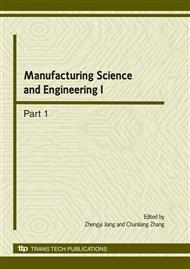p.457
p.461
p.465
p.471
p.475
p.479
p.484
p.488
p.492
Effects of Mg-Doping on Structure and Electric Properties of MgxZn1-xO:Al Ceramics
Abstract:
MgxZn1-xO:Al ceramics with low resistivity using ZnO, MgO and Al2O3 nano-powders as raw materials were obtained by unpressurized sintering. The influence of Mg content on structure and electric properties of MgxZn1-xO:Al ceramics were studied. The results indicate that there is a single phase of wurtzite structure of ZnO in MgxZn1-xO:Al ceramics at x ≤ 0.3, and when the value of x was 0.3, phase separation was observed. The grains become smaller and more homogeneous with increasing Mg content to above 0.3. The resistivity of MgxZn1-xO:Al ceramics obviously increases with increasing Mg concentration due to the decrease of the carrier concentration and the mobility deriving from the decrease of Al-doping efficiency. The electrical conduction of MgxZn1-xO:Al ceramics can be markedly improved by increasing the Al-doping level and the lowest resistivity of 8.3×10-4Ω•cm can be obtained when Mg/(Mg+Zn)=0.2 and Al/(Mg+Zn+Al)=0.03.
Info:
Periodical:
Pages:
475-478
Citation:
Online since:
March 2010
Authors:
Keywords:
Price:
Сopyright:
© 2010 Trans Tech Publications Ltd. All Rights Reserved
Share:
Citation:


